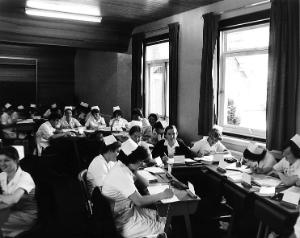Look Closer: Nursing in Tayside & Fife

An online version of the Tayside Medical History Museum exhibition
Originally staged at Ninewells Hospital
March 2005 - February 2006
This exhibition celebrates the role of nurses in medical care and explores the history of nurses' training in Tayside and Fife.
Image left: Nurses tending the wounded at Dundee Royal Infirmary during the Great War
To view more photographs click here
To view more objects click here
Read a History of Nursing Education by John Drummond
Nursing Schools
Until the late 19th century, there were no formal training schools for nurses. Students were attached to individual hospitals, and lived in hospital residences under the supervision of the Home Sister (a system begun by Florence Nightingale at St Thomas’s Hospital in London in 1861).
A more formal system of ‘block’ apprenticeship was pioneered by former DRI matron Rebecca Strong at Glasgow Royal Infirmary. This comprised short periods of instruction in a nursing school, followed by periods of practice in the various wards of the local hospital. This system soon took off internationally, and was formalised in Britain by the Midwives Registration Act of 1901 and the Nurses Registration Act of 1911. General Nursing and Midwifery Councils were set up in the 1930s to take charge of training provision on a national scale. The Royal College of Nursing, meanwhile, was established in 1916 to promote the profession and represent the interests of its members. Its founder, Sarah Swift, had trained at Dundee Royal Infirmary, receiving her certificate in 1880.
The attachment of schools to local hospitals continued until the 1960s, when smaller institutions were merged to form larger schools, managed by local Health Boards rather than the hospital Boards of Management. This gave rise to Perth College of Nursing & Midwifery, Angus College of Nursing, Dundee College of Nursing & Midwifery and the College of Nursing & Midwifery in Kirkcaldy.
Further mergers occurred in the 1980s to form Fife College of Health Studies in Kirkcaldy and Tayside College of Nursing & Midwifery here at Ninewells. Preparations were made for a move into the higher education sector, and in 1992, the initial qualifying award for nurses and midwives was changed from a certificate to a higher education diploma. In 1996, the two colleges were merged to form the School of Nursing & Midwifery, part of the University of Dundee.
With its three campuses (Airlie Place, Ninewells and Kirkcaldy), the School is one of the largest in the country, and the past few years have seen the developments of several new initiatives, including a considerable expansion of research activity and postgraduate provision. While proud of its history, the School is also forward looking in its aspirations. It strives to be an asset to its students, clinical partners, the University and the communities which it serves.
 Image right: Student nurses in the classroom, 1970s. Donated by the School of Nursing and Midwifery
Image right: Student nurses in the classroom, 1970s. Donated by the School of Nursing and Midwifery
The Fife Campus
The Fife campus of the University’s School of Nursing & Midwifery has its origins here in the Victoria Fever Hospital, which opened in 1899 with 15 probationers (student nurses). The hospital expanded in the 1960s and in 1973 merged with other nursing schools in the area to become Fife College of Nursing. The new building opened in 1986 and nurses’ training had moved out of Victoria Hospital completely by 1992, when the school became Fife College of Health Studies.